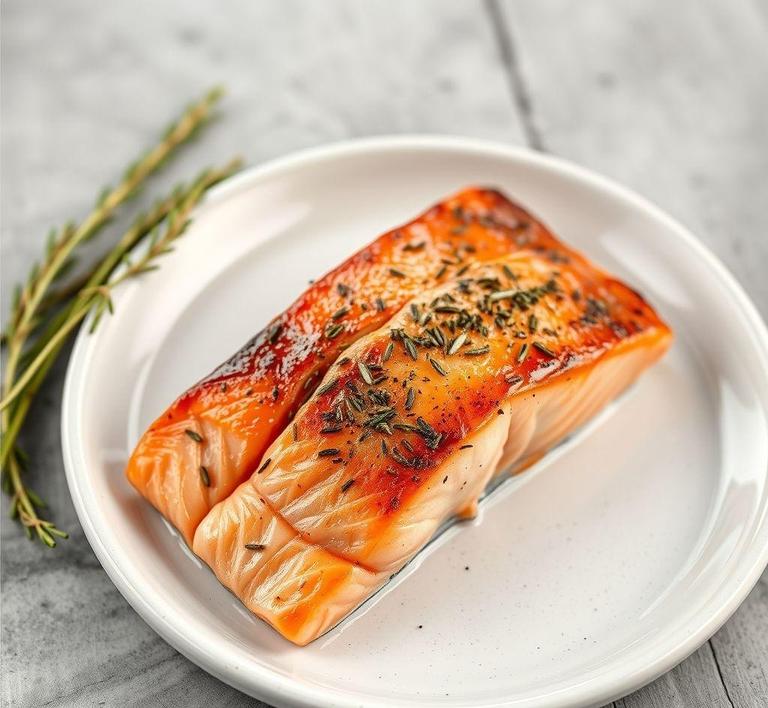If you’ve cooked too much salmon and are wondering whether it’s safe to refreeze, you’re not alone. Refreezing cooked salmon can be a bit tricky, but with the right methods, it can be done without compromising too much on taste or texture. Whether you’re looking to preserve leftovers or simply don’t want to waste food, understanding the right way to store and refreeze your salmon can help ensure it stays delicious when you’re ready to enjoy it again. In this guide, we’ll walk you through the steps and key tips for safely refreezing cooked salmon, so you can make the most out of your seafood dishes.
Can You Refreeze Cooked Salmon?

The question of whether you can refreeze cooked salmon is a common one, especially for those who find themselves with leftovers after a delicious dinner or a meal prep gone too far. Refreezing food can be a bit tricky, and salmon, being a delicate fish, raises concerns due to its texture, moisture content, and the general rules of food safety. So, the short answer is: yes, you can refreeze cooked salmon, but there are some important factors to consider before doing so.
The key issue is how the fish was handled prior to refreezing. If cooked salmon has been properly stored, kept at safe temperatures, and hasn’t been left out at room temperature for extended periods, you can freeze it again. However, the quality and texture of the fish might not be as pristine as when it was originally frozen. Refreezing involves thawing and then re-freezing, both of which can degrade food in ways that are more noticeable in sensitive proteins like fish.
To make a more informed decision, you should consider things like when and how the salmon was cooked, whether it was handled according to food safety guidelines, and whether it was fully cooled before being put in the freezer.
How To Refreeze Cooked Salmon?
If you decide to go ahead and refreeze cooked salmon, it’s essential to follow proper steps to minimize any loss of quality and to ensure safety. Here’s a step-by-step guide:
-
Cool the Salmon:
After cooking your salmon, allow it to cool down to room temperature, but make sure it doesn’t sit out for longer than two hours. If the salmon has been sitting at room temperature for more than this, it’s best not to refreeze it due to the potential growth of bacteria. If it’s been in the danger zone (between 40°F and 140°F) for more than two hours, it’s safer to discard it.
-
Package It Properly:
To prevent freezer burn and retain as much moisture as possible, it’s crucial to package your cooked salmon in airtight containers or vacuum-sealed bags. This reduces exposure to air, which can dry out the fish and impact its texture. If you don’t have a vacuum sealer, wrap the salmon tightly in plastic wrap, then place it inside a freezer-safe ziplock bag or another airtight container.
-
Label It:
Clearly label the container or bag with the date it was cooked. Salmon can typically last for about 1-3 months in the freezer, so it’s good to know when you put it in there. If you leave it for too long, the taste and texture will deteriorate.
-
Freeze Immediately:
Once your salmon is properly packaged, place it in the freezer right away. The faster you freeze it, the better the quality will remain. Try not to overload your freezer or let the fish sit out for extended periods before freezing.
-
Thawing (for Later Use):
When you’re ready to enjoy your refrozen cooked salmon, the best method of thawing is to do it slowly in the refrigerator. Never thaw it at room temperature, as that can encourage bacterial growth. If you need it quickly, you can use the microwave on a defrost setting, but this might result in uneven thawing, so it’s not the best option for preserving quality.
Quality Impact
While it’s technically possible to refreeze cooked salmon, there are definite downsides to doing so, especially in terms of texture, flavor, and moisture. Salmon is already a tender and moist fish, and freezing it twice can compromise its integrity. Here’s a closer look at how refreezing affects the quality:
-
Texture:
Freezing and thawing cause ice crystals to form within the fish’s cells. When you refreeze cooked salmon, these ice crystals expand, and as they do, they can rupture the cell walls, leading to a mushier texture upon thawing. This is particularly noticeable in salmon, which is rich in water content. The result is a soft, sometimes overly flaky, and less appealing texture.
-
Moisture Loss:
Salmon is known for its natural juiciness, but freezing and refreezing can strip it of that moisture. When salmon is thawed and reheated, much of its internal moisture evaporates, leaving it drier and tougher than before. This process is particularly noticeable if the salmon was initially cooked in a way that retained a lot of moisture, such as steaming or poaching.
-
Flavor:
While refrozen cooked salmon will generally retain most of its flavor, some subtle nuances may be lost in the process. Freezing can dull the freshness and brightness of the fish, so the flavor might be less vibrant than when it was first cooked. If the salmon was seasoned with herbs or a marinade, those flavors might not penetrate the fish as deeply the second time around, and the overall taste may feel somewhat flat.
-
Freezer Burn:
If the salmon is not packaged properly, it can develop freezer burn, which occurs when air gets into the packaging. This will cause the surface of the fish to dry out and become discolored. The affected parts of the fish will taste off and may have an unpleasant texture. It’s important to ensure the fish is well-sealed before freezing, and if it does get freezer burn, those parts should be trimmed away before cooking.
Refreezing cooked salmon is indeed possible, but it comes with a few important caveats. While it’s a perfectly viable option for preserving leftovers, you need to be aware of the potential impacts on quality. The texture, moisture content, and flavor of the fish may degrade after being frozen, thawed, and refrozen. If you decide to go ahead with refreezing, make sure the salmon is properly cooled, packaged, and stored. While it’s a safe practice if done correctly, the fish won’t be quite as tender and fresh as it was the first time around.
If you’re concerned about losing quality, it may be better to stick to eating the salmon within a few days of cooking or find other ways to use up leftovers, such as incorporating them into soups, salads, or pasta dishes. But if you’re in a pinch and need to store your cooked salmon for longer, refreezing is a reasonable option as long as you follow the correct steps to ensure safety and minimize the loss of quality.
Is It Safe To Refreeze Cooked Salmon?
Refreezing cooked salmon is a subject that often raises concerns, and for good reason. The primary factors to consider are food safety, texture, and quality. When it comes to seafood like salmon, proper handling is crucial to avoid potential risks and to maintain the flavor and nutritional integrity of the fish.
In general, it is safe to refreeze cooked salmon under specific conditions. The main concern lies in the fact that every time you freeze and thaw food, its moisture content is altered. This change can significantly affect the texture and taste of the salmon, potentially making it less appetizing. However, refreezing is safe as long as the cooked salmon has been thawed properly and has not been sitting at unsafe temperatures for extended periods.
The key consideration is whether the salmon was thawed in the fridge and not left out at room temperature. When thawing in the refrigerator, it maintains a safe temperature range (below 40°F or 4°C) that prevents bacterial growth, allowing for a more secure refreeze. If cooked salmon was defrosted improperly (for example, on the countertop), the risk of bacterial contamination rises, making refreezing dangerous.
It’s also essential to consider how the salmon was cooked in the first place. Salmon that has been thoroughly cooked will typically be less prone to bacterial growth when refrozen than partially cooked salmon. Furthermore, it’s recommended that refreezing cooked salmon is done within 1-2 days after it has been thawed to minimize any risk.
Signs That Cooked Salmon Should Not Be Refrozen
While refreezing cooked salmon is possible, there are a few critical signs to watch for that indicate it should not be refrozen. These include:
1. Off-Smell Or Sour Aroma
One of the clearest signs that cooked salmon has gone bad is an unpleasant odor. Fresh salmon has a mild, ocean-like scent, whereas spoiled salmon develops a pungent, sour smell. If the salmon has been sitting in your fridge for too long or has been improperly thawed, bacteria can multiply rapidly, producing these off-putting aromas. If your salmon smells bad, it’s best to discard it.
2. Discoloration Or Slimy Texture
Fresh, properly cooked salmon should have a firm, moist texture. If the fish has become slimy or discolored (turning from pinkish-orange to dull brown or gray), it has likely spoiled. Any signs of texture or color changes, especially after being frozen and thawed, suggest that refreezing may no longer be a safe option.
3. Visible Signs Of Mold
If you notice mold spots on the surface of the salmon, discard it immediately. Mold can develop on cooked seafood that has been stored too long in a refrigerator or freezer. Mold growth is a clear indication that the fish is not safe to eat, even after refreezing.
4. Excessive Dryness
If the cooked salmon appears dry and has lost a significant amount of its natural moisture, it might be an indication that it has been frozen and thawed multiple times. This excessive dryness can negatively impact its texture and flavor, making it unsuitable for refreezing.
5. Room Temperature Exposure
If the cooked salmon was left out at room temperature for more than 2 hours (or 1 hour if the room temperature is above 90°F or 32°C), bacteria could have begun to proliferate. In this case, it is not safe to refreeze it, as harmful bacteria might not be destroyed even with refreezing.
Common Refreezing Mistakes
Refreezing cooked salmon can be tricky, and there are several common mistakes people make when attempting to do so. Avoiding these mistakes can help you ensure that your salmon is safe and enjoyable the next time you eat it.
1. Refreezing After Multiple Thaws
One of the biggest mistakes is thawing and refreezing the salmon multiple times. Each time the fish is thawed, bacteria have a chance to proliferate, especially if it’s exposed to temperatures above 40°F (4°C). Ideally, once salmon has been thawed, it should either be eaten immediately or refrozen once. Multiple freeze-thaw cycles can also degrade the quality and texture of the salmon, leaving it tough and unappetizing.
2. Not Properly Wrapping Or Storing
If cooked salmon isn’t tightly wrapped or stored in an airtight container before freezing, it will be exposed to freezer burn. Freezer burn causes the salmon to dry out and develop unsightly ice crystals, which lead to a loss in flavor and texture. To prevent freezer burn, always wrap your cooked salmon in plastic wrap or aluminum foil, and then place it in a zip-top bag or airtight container before freezing.
3. Refreezing Salmon Left At Room Temperature
Leaving cooked salmon at room temperature for too long before freezing is a recipe for disaster. Bacteria thrive between 40°F (4°C) and 140°F (60°C), so leaving salmon at room temperature for more than a couple of hours can put it in the danger zone. If it’s been sitting out too long, it’s better to throw it away than risk illness by refreezing it.
4. Refreezing Cooked Salmon Without Proper Thawing
Thawing salmon on the countertop is another mistake that’s often made. To thaw cooked salmon safely, always place it in the fridge for several hours or overnight. Thawing at room temperature allows bacteria to grow, which makes refreezing unsafe. If you’re in a rush, you can use the microwave’s defrost setting, but this should be done only if you plan to eat the salmon immediately.
5. Freezing Salmon That Was Never Properly Cooked
If you freeze salmon that was undercooked in the first place-whether slightly raw in the center or not cooked to a safe internal temperature-it can pose a health risk after being thawed and refrozen. Always cook salmon thoroughly (to an internal temperature of 145°F or 63°C) before freezing to reduce any risk of foodborne illness.
Tips And Tricks
Here are some helpful tips and tricks to ensure your cooked salmon stays safe and delicious after refreezing:
- Freeze in Portions: If you don’t plan on eating the entire batch of cooked salmon, freeze it in smaller portions. This allows you to thaw only what you need without having to refreeze leftovers, which can impact quality.
- Use Vacuum Sealing: To prevent freezer burn, consider vacuum sealing your cooked salmon. This method removes air from the packaging and creates an airtight seal that helps maintain the fish’s freshness.
- Label Your Freezer Bags: Always label your freezer bags with the date that the salmon was cooked and frozen. This helps you track how long it’s been in the freezer, ensuring you don’t leave it too long before consumption.
- Thaw Slowly: When you’re ready to eat your refrozen salmon, allow it to thaw slowly in the refrigerator rather than using a microwave or quick-thaw methods. This helps maintain the texture and prevents a soggy outcome.
- Revitalize the Texture: After refreezing and thawing, you can use methods like gently reheating the salmon in the oven with a light coating of olive oil or butter. This can help restore some moisture and flavor.
Conclusion
While it’s technically safe to refreeze cooked salmon, there are many variables to consider before doing so. The key to successfully refreezing salmon lies in its handling-ensure it’s been properly cooked, cooled, and stored. Pay attention to signs of spoilage, avoid common refreezing mistakes, and follow best practices to maintain quality. By adhering to these guidelines, you can enjoy your cooked salmon again without compromising food safety or taste.
In summary, refreezing cooked salmon is a practical way to reduce food waste, but it’s crucial to handle it with care. When done correctly, your refrozen salmon can remain just as tasty and nutritious as the first time you cooked it.


